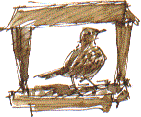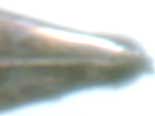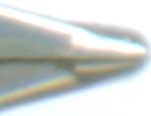Black and BlueThursday, 9th May 2002, West Yorkshire |
![]()
![]()
![]()
![]() Rocks |
History |
Workshop |
Links |
Home Page
Rocks |
History |
Workshop |
Links |
Home Page
![]()
 One of the young blackbirds is playing king of the castle as he sits on top of the bird table, seeing off the sparrows. As well as learning to see off rivals of their own and other species the three blackbird youngsters are learning a lot about their home territory. They've been introduced to the local drinking hole - our garden pond - and they've already discovered that some of the best places to eat include the depths of the shrubbery and the wood chip garden path. Adults and juveniles have been raking around on the path with such enthusiasm that there are now four
One of the young blackbirds is playing king of the castle as he sits on top of the bird table, seeing off the sparrows. As well as learning to see off rivals of their own and other species the three blackbird youngsters are learning a lot about their home territory. They've been introduced to the local drinking hole - our garden pond - and they've already discovered that some of the best places to eat include the depths of the shrubbery and the wood chip garden path. Adults and juveniles have been raking around on the path with such enthusiasm that there are now four  or five holes in the old chippings at irregular intervals, revealing circles of the black plastic compost bags that I've used as a weed barrier beneath. It looks as if some large creature has strolled down the path leaving deep footprints behind it.
or five holes in the old chippings at irregular intervals, revealing circles of the black plastic compost bags that I've used as a weed barrier beneath. It looks as if some large creature has strolled down the path leaving deep footprints behind it. The female blue tit pops out of the nest box on the house wall next door and comes to our bird table a few yards away, where the male is waiting to feed her. She begs for food like a chick, flicking her wings impatiently. The male has a perkier looking blue crest on his head. The female looks rather crestfallen and worn, as if the business of incubating is taking it out of her. She flies off for a brief break down the garden after taking what seems no more than a ritual beakful of food from the male.
The female blue tit pops out of the nest box on the house wall next door and comes to our bird table a few yards away, where the male is waiting to feed her. She begs for food like a chick, flicking her wings impatiently. The male has a perkier looking blue crest on his head. The female looks rather crestfallen and worn, as if the business of incubating is taking it out of her. She flies off for a brief break down the garden after taking what seems no more than a ritual beakful of food from the male. I'm not sure if there are chicks in the nest yet. Later I see the male perched on a plant at the back of the herb bed. He appears to drop a white faecal sack from his beak, so perhaps they do have young now. These faecal sacks are the bird equivalent of the disposable nappy (U.S.; diaper). Carrying them away from the nest helps make it less obvious to predators. Although in this case it would be difficult to miss the little bird house screwed onto the expanse of brick wall.
I'm not sure if there are chicks in the nest yet. Later I see the male perched on a plant at the back of the herb bed. He appears to drop a white faecal sack from his beak, so perhaps they do have young now. These faecal sacks are the bird equivalent of the disposable nappy (U.S.; diaper). Carrying them away from the nest helps make it less obvious to predators. Although in this case it would be difficult to miss the little bird house screwed onto the expanse of brick wall.His Nibs
My favourite pen for drawing is a Rotring Art Pen with an extra fine sketch nib. I've got three of them on the go; one containing brown ink, one black and the other black with a fine, rather than extra fine, nib. The majority of the sketches in this diary were done using one or the other of them.
I hadn't realised how long I'd had them; the oldest must be more than ten years old. When you think how many times you'd replace a toothbrush over that period it's surprising that it never occurred to me that it was about time I replaced them.
For a while I've found it increasingly difficult to draw with one of them. Even after a thorough cleaning out I couldn't get the ink to flow. These scans show the reason; the new nib looks like a space shuttle while the old looks like an exhibit from an archaeological museum.
 |
 |
Of course the fountain pen ink that I use in them is soluble so if you add a watercolour wash it runs. Depending on the subject this is less of a problem with the brown than the black. I often use watercolour crayon (applied dry) to finish off a pen and ink sketch. Of course if you're doing a pen and ink and wash sketch you can use this to your advantage, dipping a watercolour brush in clean water and painting over parts of the drawing to turn some of the pen lines into partial tonal washes.
![]()
Richard Bell,
wildlife illustrator
E-mail; 'richard@willowisland.co.uk'
![]() Next page
Previous page
This day in 2000 |
This month |
Nature Diary |
Home Page
Next page
Previous page
This day in 2000 |
This month |
Nature Diary |
Home Page
![]()